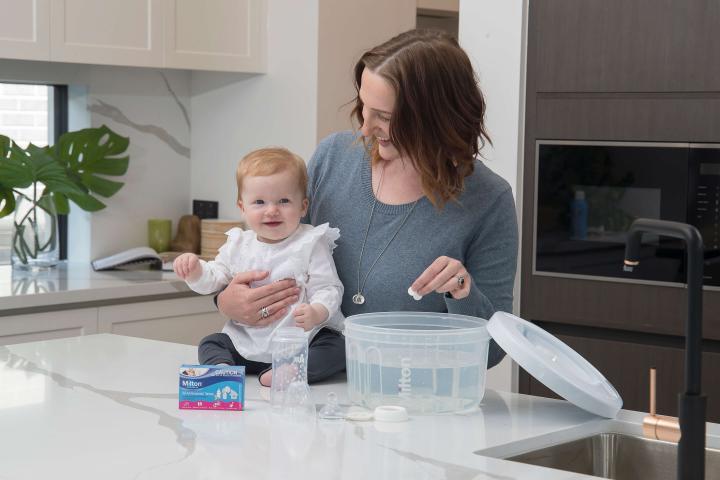Why it’s important to sterilise your baby’s bottles until they’re one
In the first 12 months of life, a baby’s immune system is still developing and is immature. This means they’re more vulnerable than older babies to getting an infection. If they do get sick, they may not recover as quickly as babies whose immunity is more

Milk – the perfect food to grow
Germs, including viruses and bacteria, can grow quickly in milk which is why sterilising bottles and storing milk safely helps to reduce the risk of contamination. Milk is the perfect medium for germs to grow. You have choices about how you sterilise your baby’s feeding equipment, though one popular option is to use an antibacterial solution. Also known as chemical sterilising, antibacterial solutions come in either a tablet or liquid form which is dissolved in cold water.
Antibacterial sterilising solution is a type of bleach but because it’s diluted with water, it’s safe to use for babies feeding equipment. It’s important to prepare the solution the right way so it’s effective in killing germs but there’s no harm to the baby.
What would I need to sterilise?
If you’re breastfeeding and expressing your milk, then you will need to sterilise all parts of the breast pump which come into contact with milk. The bottles and containers you store expressed breast milk (EBM) also need to be sterilised. If you’re bottle feeding, then all bottles, teats, caps and lids need to be sterilised as well.
If your baby uses a dummy, that can go into the sterlising solution as well. Storing dummies in the solution is a good option for safe use.
What’s important to know about using antibacterial solution?
- Use a plastic or glass container to hold the sterilising solution to soak feeding equipment. Don’t put any metal in the solution because it will rust.
- Prepare the solution exactly as the manufacturer recommends.
- You will need to carefully wash and rinse all bottles, teats and feeding equipment before soaking them. Use warm soapy water and then rinse in cold water as soon as possible after every feed.
- Use cold water to dilute the tablets or solution.
- Completely submerge everything which is going into the solution. It’s important there are no air pockets which will prevent all the surfaces coming into contact with the solution. If lighter plastic is floating to the top, use something heavy like a plate to submerge the items.
- Squeeze the solution through the teat holes to make sure they’re not blocked with milk.
- Cover the solution with a firm fitting lid.
- Leave everything in the solution for the recommended time. A minimum time recommended by manufacturers is 15 minutes. If you need to add more equipment to what’s already sterilising, start timing from the beginning again.
- Wash your hands before using tongs to remove bottles/teats etc from the solution and handling sterilised equipment.
- There is no need to rinse the solution off the bottles/teats. Just shake off the excess.
- You can store sterilised feeding equipment in a clean, sealed container in the fridge for 24 hours.
- Replace the solution every 24 hours. After this time, it’s not effective. Wash the soaking container in warm soapy water, rinse well and make up a new batch of solution.
Written by Jane Barry, Midwife and Child Health Nurse. September 2021.
